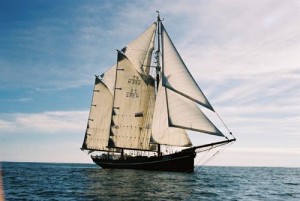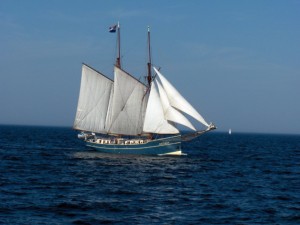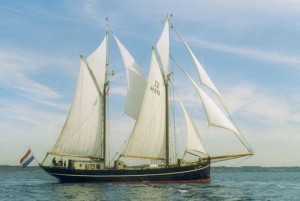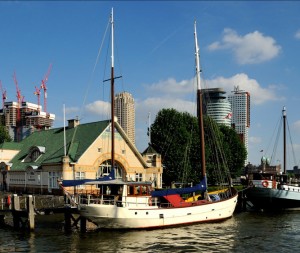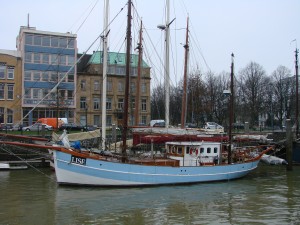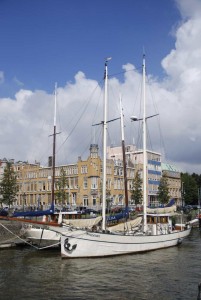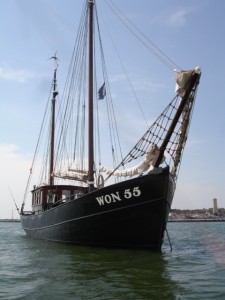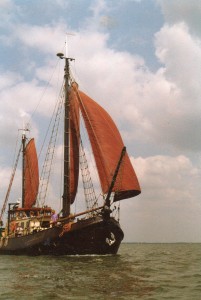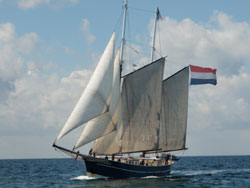Vessels
The Veerhaven is the homeport for our sea-going maritime heritage. These are all extraordinary classic ships. The majority of the ships are privately owned. Several ships are also used for sailing trips, events and/or parties.
Types of ships to be admired in the Veerhaven. (Text by Frits Loomeijer)
Lugger
The French type of ship ‘Lougre’ was introduced in Dutch herring fishing in 1866 and within a short period of time it replaced the buizen and hoekers that had been used for centuries before that time. Its sharp hull and relatively small displacement made it sail faster with a smaller crew than the traditional Dutch herring ships. Under the corrupted name ‘logger’ it remained the most important type of ship for the Vlaardingen, Maassluis and, as from the 20th century also, Scheveningen fishing fleet. Until 1969 luggers were actively used in Dutch herring fishing. The trawler succeeded the lugger.
[one_half]
[/one_half][one_half_last]
Iris
- Type of ship: lugger
- Year of construction/shipyard: 1916, Figée. Vlaardingen
- Overall length: 36 m.
- Deck length: 28.50 m.
- Width: 6.7 m.
- Draft: 2.8 m.
- Number of masts, sail area.: 2 (wood), 500 Sq m
- Type of build: steel, riveted
- Engine: Detroit V8, 320 hp.
- Navigation area: European coastal waters
- Present use: charter
- Capacity for sea-travel: 12 passengers
- More information on charter trips with this ship: www.de-iris.nl
[/one_half_last]
Until 1920 the Iris was a successful herring lugger fishing on the North Sea under the name Pallas. In 1920 she was sold to Sweden and was converted to cargo vessel. In 1975 she came back to the Netherlands and was converted to a sailing charter vessel under the name “Geesje van Urk”. The present owner bought the ship in 2001 and renamed her too “Iris”. During the summer season the Iris sails charters with small groups.
[one_half]
Luciana
- Type of ship: lugger (schooner rigged)
- Year of construction/shipyard: 1916, Gebr. Pot at Elswood
- Overall length: 39 m.
- Deck length: 29 m.
- Width: 6.54 m.
- Draft: 2.5 m.
- Number of masts, sail area: 2 (wood), 450 sq mtrs
- Type of build: steel, riveted
- Engine: KHD, 150 hp.
- Navigation area: North Sea, Baltic
- Present use: charter
- Number of persons on board: 24 guests
- More information on charter trips with this ship: www.europesailing.nl
The Luciana was build in 1916 als a sailing herring lugger without engine with the fishery number VL173 and named “Cornelia en Petronella”. Later names were KW66 “Marcus Aurelius and “Twee Gebroeders”. She was sold to Sweden in 1929 to become a cargo vessel first named “Marcus Aurelius” and from 1976 “Sjonorrun”. In 1982 she came back to the Netherlands to be converted to a sailing charter vessel.
[one_half] [/one_half] [one_half_last]
Lotos
- Type of ship: lugger
- Year of construction/shipyard: 1910, Figée, Vlaardingen
- Overall length: 36 m.
- Deck length: 27 m.
- Width: 6.5 m.
- Draft: 2.7 m.
- Number of masts, sail area: 2 (wood), 420 sq mtrs
- Type of build: steel, riveted
- Engine: Fiat-Iveco, 360 hp.
- Navigation area: European coastal waters
- Present use: private
The Lotos sailed as a herring lugger for Rederij Roeleveld, Scheveningen, till 1929. She was laid up in Scheveningen for ten years in Scheveningen and Vlaardingen until she was sold to Norway in 1939. She was motorised and converted to a cargo vessel carrying the names Lotos, Haugland, Sonnodd, Mo, Laredo successively. Named “Red Herring” she came back to the Netherlands in 1993. She was named “Lotos” and converted to sailing charter vessel in 1997 and sailed charters with passengers for a number of seasons. The present owner bought her in 2010 and converted her for private use.
Fishing cutter
Originally the cutter was a fast, sea-going sailing ship mainly used by the navy in North-western Europe and the United States. The cutter developed in a number of ways in the various parts of Europe and around 1900 the type was predominantly used for fishing and piloting. In Scandinavia, Germany and Scotland wooden cutters were built for fishing until the end of the 20th century. The cutter hull lent itself particularly well for motorization and in the Netherlands as from the 1920s a separate development took place: the steel motor cutter. As a small trawler the motor cutter consequently swept Dutch coastal fishing and still is the predominant fishing vessel in our country albeit in heavily modernised form.
[one_half]Lammie
- Type of ship: cutter
- Year of construction/shipyard: 1935, Woubrugge
- Overall length:
- Deck length: 21.24 m.
- Width: 5.60 m.
- Draft: 2.35 m.
- Number of masts, sail area.: 2 (steel), 260 sq mtrs
- Type of build: steel, riveted
- Engine: Daf, 180 hp.
- Navigation area: worldwide
- Present use: private
The Lammie was built as a fishing cutter and under the name “Trust”, TX39 fished from Texel. In the early 70s she came into private hands. She became a notorious smuggling vessel under the name Lammie (HD160). In 1978 she was converted into a sailing charter vessel and sailed the Mediterranean. In 1983 the ship returned to the Netherlands for private use under the name Lisa. The present owners renamed the ship Lammie again.
[one_half]
[/one_half]
[one_half_last]
Lise
- Type of ship: haicutter
- Year of construction/shipyard: 1935, Nipper at Skagen (Dk)
- Overall length: 20 mtrs.
- Deck length: 15.60 m.
- Width: 4.35 m.
- Draft: 1.80 m.
- Number of masts, sail area.: 2 (wood), 120 sq mtrs
- Type of build: wood, oak on oak frame ribs
- Engine: Volvo Penta TMD 100c, 240 hp. Turbo, year: 1985
- Navigation area: North Sea, European inland waterways
- Present use: private
[/one_half_last]
The Lise was fishing in North Sea until 1989. After a thorough conversion by the previous owner into a private ship she got two masts and was cutter rigged. The name Haicutter is derived from the word “haai”, Dutch for shark. These were the first motorized cutters and very often they were in the fishing grounds first because their hulls cut through the water like a shark.The present owners live on the Lise sailing in the IJsselmeer,Wadden, and North Sea area.
[one_half]
Phoenix
- Type of ship: cutter (staysail schooner)
- Year of construction: 1931
- shipyard: Stapel-Spaarndam
- Overall length: 26 m.
- Deck length: 20.05 m.
- Width: 5.40 m.
- Draft: 2.40 m.
- Number of masts, sail area.: 2 (steel), 240 sq mtrs
- Type of build: steel, riveted
- Engine: 12 cyl. Kromhout, 300 hp., Year: 1966
- Navigation area: worldwide
- Present use: private/charter
The Phoenix was built as a North Sea fishing cutter, TX32, at the shipyard “Vooruit”at Spaarndam. On completion the ship was provided with two masts and rigged with a main sail,a mizzen sail and a jib sail with a total sail area of 98 square meters and an air-launched, two cylinder Kromhout. The ship was sold several times and eventually served as an Urk fishing cutter. There she lay submerged for a few years. In 1974 she was lifted and restored in Amsterdam. Deck wheelhouse, bulwarks and gunwale were renewed and she was provided with the present sail plan. In addition a 12 cylinder Kromhout was installed.
[one_half] [/one_half] [one_half_last]
WON 55
- Type of ship: cutter
- Year of construction/shipyard:
- Overall length:
- Deck length: 14.95 m
- Width: 3.65 m
- Draft:1.65 m
- Number of masts, sail area.: 2
- Type of build:
- Engine:
- Navigation area:
- Present use: private
Originally the ‘botter’ is a fishing vessel with a flat bottom, a high bow and low stern which was developed in the 18th century in the Zuiderzee area.
For coastal fishing on the North Sea a heavier and more seaworthy variant emerged: the North Sea botter. With the introduction of the engine in coastal fishing, shortly after the WW1, many originally sailing North Sea botters were made higher and provided with a wheelhouse. In addition, until the mid-thirties some tens of steel North Sea botters were built. They were the direct predecessors of the steel engine propelled cutters being developed at that time.
[one_half]
Okke
- Type of ship: North Sea botter
- Year of construction/shipyard: 1928, Amels at Makkum
- Overall length: 17.80 m.
- Deck length: 16 m.
- Width: 5.4 m.
- Draft: 2.05 m.
- Number of masts, sail area.: 2 (wood), 130 sq mtrs
- Type of build: steel, riveted
- Engine: 6 cyl. Cummings, 155 hp.
- Navigation area: European coastal and inland waterways
- Present use: private
The Okke was fishing in the Dutch coastal waters until 1968. Initially shrimp, later pair trawling. From the end of the fifties till 1968 she was beam trawling. In 1970 she was converted a private sailing vessel.
Schooner
The Schooner derives its name from the schooner rigging developed in the Netherlands from a 17th century two-mast rigging with the rear-most mast being longer than the front one. The rigging as well as the hull were further developed in North America into a fast combination used in the navy, in smuggling, specialised freight trade and as a pleasure vessel after which the schooner came back to Northern Europe at the end of the 18th century. As from the second half of the 19th century this type of ship became popular in Northern European freight traffic. In the Netherlands between 1880 and 1919 iron and steel freight schooners were built in large numbers for the European and Trans-Atlantic freight trade
[one_half]
[/one_half]
[one_half_last]
Oosterschelde
- Type of ship: Three-masted topsailschooner
- Year of construction: 1918
- Shipyard: Appelo, Zwartsluis
- Overall length: 50 m.
- Deck length: 40.12 m.
- Width: 7.5 m.
- Draft: 3 m.
- Number of masts, sail area.: 3 (wood), 891 sq mtrs
- Type of build: steel, riveted
- Engine: 6 cyl. Deutz, 360 hp.
- Navigation area: worldwide
- Present use: charter
- Capacity for sea-travel: 24 passengers
- Capacity for daytrips: 120 passengers
- More information on charter trips with this ship: www.oosterschelde.nl
[/one_half_last]
The Oosterschelde was built as sailing cargo vessel fitted with a small engine. She sailed the European seas till 1930 carrying cargoes like timber, stones, china clay, grain, but also potatoes and straw. In 1930 she was fitted with a larger and more modern engine and the rigging was reduced. In 1950 she was converted to a ‘modern’ coastal trader. In 1988 she came back to the Netherlands and with the support of a great many people, companies and funds she was restored to the last remaining representative of a fleet of hundreds of 3 mast topsail schooners that sailed under Dutch flag in the beginnen of the twentieth century.
[one_half]
Catharina
- Type of ship: schooner
- Year of construction/shipyard: 1925
- Overall length: 40 m.
- Deck length: 32 m.
- Width: 6.24 m.
- Draft: 2.90 m.
- Number of masts, sail area.: 2 (steel), 385 sq mtrs
- Type of build: steel
- Engine: Daf 1160, 160 hp.
- Navigation area: North Sea, Baltic
- Present use: charter
- Number of persons on board: 24 guests
- More information on charter trips with this ship: www.europesailing.nl
The Catherina was built as a composite (wooden hull with steel frames) minesweeper for the German navy in 1925. In 1925 the hull was converted to steel in Belgium and she was lengthened to her present length. She has been fishing in the North Sea under Belgian flag until 1982. Since 1985 she is a sailing charter vessel.
[one_half]

Amazone
- Scheepstype: driemastschoener
- Bouwjaar/werf: 1929, v. Diepen, Waterhuizen
- Lengte over alles: 42 m.
- Lengte over dek: 34 m.
- Breedte: 6,2 m.
- Diepgang: 1,7 m.
- Aantal masten, zeilopp.: 3 (staal), 550 m2
- Bouwwijze: staal, geklonken
- Motor: Caterpillar, 320 pk., DAF, 230 pk.
- Vaargebied: Nederlandse binnenwateren
- Huidig gebruik: (dag)charter
Meer informatie over chartervaarten met dit schip: In de eerste helft
van de 20eeeuw leverde de Amazone, gebouwd als Wad- en Sontvaarder,
haar bijdrage aan de vrachtvaart in de Oostzee en de Duitse rivieren met
kapitein Wilhelm Haalck als gezagvoerder. Het onvermijdelijke lot van vele
zeilende kustvaarders trof echter ook de Amazone. Zij werd ingezet als stenenvisser.
In 1984 werd zij als economisch ondoelmatig opgelegd in Flensburg. Ware het niet
dat sinds de jaren ’70 de zeilende chartervaart met passagiers in opkomst kwam, dan
was waarschijnlijk de scheepssloperij het einde van de Amazone geweest. In 1991
kwam zij in het bezit van de huidige eigenaren en werd een begin gemaakt met de
volledige renovatie en ombouw tot luxe zeilend partyschip. In mei 1994 was het
werk voltooid en kwam de Amazone als herboren opnieuw in de vaart.
“Wad- en Sontvaarder”
The “Wad- en Sontvaarder” is a transformation type of ship in two ways: between sail and engine and between sea en inland navigation. In the Netherlands it was only built for a short time for Dutch and German owners between 1920 and 1932 as a link between the sailing ships of the coastal trade (sea tjalks, schooners and “schoeneraken”) and the motorized coaster of the 30s.
A “Wad- en Sontvaarder” was half sailing, half motor ship. When, in the early 30s, the high-pressure maritime diesel engine came on the market the “Wad- en Sontvaarder” was already in fact obsolete. Shortly after the Second World War this type of ship disappeared from Dutch coastal navigation. The navigation area of these ships were the southern North Sea, Waddensea and the Baltic.
[one_half]
Emma
- Type of ship: “Wad- en Sontvaarder”
- Year of construction: 1931
- Shipyard: v. Diepen, Waterhuizen
- Overall length: 36 m.
- Waterline Length: 34 m.
- Width: 6,10 m.
- Draft: 1,70 m.
- Type of build: steel, riveted
- Engine: Deutsche Werke 3M423, 150 hp.
- Navigation area: Dutch coastal and inland waterways
- Present use: private

In 1939 werd de Emma met 6,20 meter verlengd en ge(her)motoriseerd.
Tot 1968 was zij in bezit van de familie Hamann te Barnkrug; vervolgens diende zij tot 1981
als schelpenbaggerschip te Wijk auf Föhr. Tot 1994 lag zij afgemeerd als winkelschip te Lelystad-Haven
(Tagrijn Emma). Sindsdien is zij in het bezit van de huidige eigenaren.
Van buiten bleef het historisch karakter zoveel mogelijk behouden, van binnen werd zijn omgebouwd tot moderne woning.
Coaster
The term coaster emerged in the Netherlands shortly before the Second World War when newly built motor ships with a carrying capacity of approximately 250 to 400 tonnes had almost completely replaced former sailing and motor ships in Dutch coastal trade.They attracted international attention because they transported relatively much cargo with a small crew. The coaster developed during those years dominated the Northwest European coastal trade until the late 60s of the 20th century.
[one_half]

Zwerver
- Type of ship: coaster
- Year of construction: 1929
- Shipyard: Fa. Boot, Gouwsluis
- Overall length: 36 m.
- Width: 6,5 m.
- Draft: 1,90 m.
- Number of masts: 2 (steel)
- Type of build: steel, riveted
- Engine: Bolnes 4L, 200 hp., year.1952
- Navigation area: European coastal waters
- Present use: Work vessel, homebase of Serendipity UnLtd, nautical consultancy
- More information about Serendipity UnLtd: www.serendipity.nl
In 1929 liep de Zwerver voor de familie Otte van stapel. Vader Otte voer met zijn familie
tot na de 2e Wereldoorlog met dit schip. Zijn oudste zoon had de zeevaartschool doorlopen en met
deze papieren mocht het schip vracht vervoeren over zee. Verschillende (Nederlandse) eigenaren hebben
het schip in bezit gehad. In 1980 kocht de huidige eigenaar dit schip in zwaar
verwaarloosde staat. Na vele jaren van restaureren is het wederom een zeewaardig schip.
Tugboat
The earliest form of mechanised shipping is tugging. After the introduction of the steam engine, in the first quarter of the 19th century, in Dutch shipping special steamships were built which had to tug other ships in case of a lack of wind or to give assistance to ships entering or manoeuvring in the harbours. Thus the tug came into existence: a relatively small ship with comparatively much engine power. Since the 30s new tugs were exclusively built with diesel engines.
[one_half]
Prinses Gerretje
- Type of ship: converted tug
- Year of construction:
- Lengte:
- Width:
- Draft:
- Type of build: steel, riveted
- Engine:
- Navigation area:
- Present use: private

Sailing yacht
The term sailing yacht nowadays is an umbrella term for all sorts of ships used for recreational purposes. However, originally it had a different meaning. At the end of the 16th, beginning 17th century the Dutch “jacht” developed. A ship used for various purposes with a flat, heart-shaped stern. In various languages the word yacht has remained to be associated with that type of stern. In the Netherlands and in English, however, one specific form of the 17th century yacht remained attached to the term: the recreational ship of the Dutch Elite. That is why, four hundred years later we use the term yacht when we see a sailing or motor ship
[one_half]

Sage
- Type of ship: Sailing yacht (gaff topsail schooner)
- Year of construction: 1997
- /shipyard: De Vries, Lemmer
- Overall length: 20 m.
- Deck length: 15,80 m.
- Width: 4,80 m.
- Draft: 2,20 m.
- Number of masts, sail area.: 2 (steel), 160 sq mtrs
- Type of build: steel, welded
- Engine: 6 cyl. Daf, 120 hp.
- Navigation area: Dutch coastal and inland waterways
- Present use: (day)charter/private
De Sage werd als casco gebouwd naar een ontwerp van Brekebrede en in eigen beheer afgebouwd.
In 1999 kwam het schip in de vaart. Er worden dagtochten mee gevaren met kleine gezelschappen.

